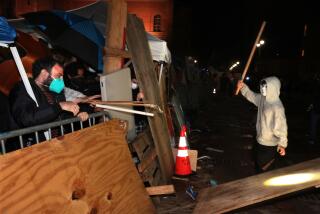Reporting live from the front lines of protest is his stream job
- Share via
The man who goes by CrossXBones finagled his way into the center of the scrum. Sweat beaded on his shaved head, an American Spirit cigarette dangled from his mouth and a massive can of energy drink was holstered on the strap of his backpack.
Hundreds of protesters had taken over the parking lot in front of police headquarters in Anaheim, where police shootings over the summer had stirred anger in the densely packed neighborhoods in the heart of Orange County’s largest city. Protesters scrawled messages in chalk condemning police and chanted as officers on horseback galloped by.
But CrossXBones, as Sky Adams is known online, was not one of them.
Instead of being armed with signs or chalk, Adams wore a headset and held a smartphone, its broadband connection linking him — at that moment — with hundreds of others. Adams would be their eyes and ears when it came to this latest unrest.
“I’m not an activist,” Adams explained. “I’m just a journalist.”
In many ways, Adams is similar to those spurred to action over their indignation with the status quo — whether it pertains to financial institutions, politics or police behavior. He is a 35-year-old who stepped away from a job that gave him stability but not fulfillment. Now he is constantly moving and putting himself in such precarious places that he often has a gas mask in his pocket and a helmet hooked to his belt loop.
His new life also comes with the rush of being at the front lines of a movement.
Interactive timeline: Occupy Wall Street
Adams provided an on-the-ground perspective to viewers when police swept through the lawn of Los Angeles City Hall last November, clearing the holdouts from Occupy Los Angeles. He did the same during protests in Chicago outside a NATO conference and the Occupy demonstrations in Oakland. More recently in Anaheim, he filmed as protesters shattered shopping center windows and lit fires in dumpsters, and as police responded by firing beanbags into the crowd.
Now on this Sunday afternoon, blocks from where fires had burned days before, a woman whose son was killed by police implored the crowd to shun more violence. “I’m not asking!” Theresa Smith bellowed into a bullhorn. “I’m demanding!”
Adams stood just feet away, wedged between protesters and news cameras.
CrossXBones was streaming live.
::
Adams is one in a collective of street journalists whose passion was kindled in the encampments that sprung up across the country last year as part of the Occupy Wall Street movement. Since then, he and other streamers have traveled from protest to protest to provide what they see as an unfiltered view of events as they unfold.
They have been enabled by technology, allowing them to broadcast with only a smartphone, a data plan and enough battery life to keep them running.
Streamers, for the most part, don’t have formal journalism experience or training. Some veer into commentary or even taunt the authorities. But others subscribe to the journalistic canon of being an impartial observer, offering live streams with bare-bones narration.
“It’s another tool, and technology is neutral. I’m not part of their agenda,” said Tim Pool, who began streaming in New York’s Zuccotti Park, where Occupy Wall Street began. “It’s an outlet to collect information and opening a window to something people may care about.”
Pool, 26, said he has had millions of viewers tuning into his “TimCast.” At one point during Occupy Wall Street, he claimed that nearly 750,000 people were watching.
He calls himself a social media journalist, and like other streamers, he has been driven in part by an aversion to coverage by mainstream media outlets. He remembered thinking: One television network during Occupy Wall Street showed only ragged transients in the crowd while another focused on clean-cut professionals. “It’s just people who are here, just everybody,” he said. “Why can’t they say that?”
In some respects the distaste is mutual, but a symbiotic relationship has emerged. Traditional reporters tend to be skeptical of a roving band of people with cellphones calling themselves journalists, yet some are quick to click on to their feeds and television stations have replayed their footage. Some streamers are often appreciative of their work being spread.
Pool, who moved to Los Angeles from New York earlier this year, has given up on accepting donations — which many streamers rely upon — because he doesn’t see it as sustainable. He’s trying to find other ways to finance his work.
“Right now, I’m burning through savings to do this,” he said, adding: “But it’s really cheap to do.”
::
On a Saturday morning, as Anaheim’s Stoddard Park bustled with children’s soccer games, a handful of streamers and would-be streamers sat in a circle on a shaded hill. The protest at police headquarters was set for the next day and organizers had put together a workshop on how to stream.
“It’s a powerful, nonlethal weapon,” said one streamer, a woman from Los Angeles who goes by the name Freedom.
Freedom, Adams and a streamer from Oakland went through a checklist: Set up accounts on Ustream, the website that serves as their platform, and on Twitter. Have plenty of battery power, because without enough juice a feed will last only 90 minutes, tops.
Other recommendations: The footage will have a longer shelf life if it’s cut up into highlight reels posted on YouTube and elsewhere. So be sure to stop every two hours; otherwise the file becomes far too large to archive what’s been captured.
Theirs is a world framed by caution and fear. Freedom doesn’t give her name, she said, because she is worried about threats to her safety (she has received them in the past). The streamers urged the newcomers to password-protect their phones in case they are confiscated by police or, as happened to Freedom in Oakland, pilfered by a mugger.
Freedom met Adams at Occupy L.A. He shared his battery pack with her.
Adams, who lives in Studio City, started streaming last fall as he watched the movement fermenting in front of City Hall. “I felt a lot of information wasn’t getting out,” he said. So he quit his job as a computer programmer for an insurance company to cover protests, living off viewer donations that haven’t always been enough to make ends meet.
“I felt like I was doing something important,” he said, “being out there and covering it.”
::
Adams wasn’t the only one prepared for the worst as 300 or so people crammed into the parking lot in front of Anaheim police headquarters, spilling into the street and onto the lawn of the public library next door. Protesters carried gas masks and first-aid materials. Police were in riot gear. Even the police horses had shields over their faces.
Adams was dressed like an Occupy-style professional: He wore a burgundy dress shirt, tie, vest and a nose ring. He did display one bit of commentary, a patch safety-pinned to his chest: WAR?
“We still have these guys on the roof,” Adams told his viewers, pointing to the officers atop the police building and the roof of a bank building across the street.
The swelling crowd was angry. But they were heeding the mother’s plea to avoid violence.
Adams had been streaming for two hours, and it was time for a break. “I’m going to archive this footage, and I’m going to be immediately back,” he said into the headset.
As the footage uploaded, Adams relaxed. He lit up an American Spirit and gave one to a stranger passing by. Adams studied acting, and he said streaming isn’t all that different from the stage. “There are elements of live theater performance,” he said.
The crowd started moving. Adams quickly resumed his feed.
“People are marching south,” he told viewers. “I understand they may be marching in the direction of Disneyland.”
Hundreds moved through the street, halting traffic as they chanted and cursed at police. Adams ran alongside them, recording, until he got to an intersection with a red light. They kept going. He stopped. Best to avoid a jaywalking ticket, he figured. “I’m kind of a target,” he said.
The marchers continued for more than a mile until they were corralled by authorities and ushered back to police headquarters. Adams, his face almost as red as his shirt, made his way to the median and ran alongside the protesters, filming.
Their numbers had been thinned, and those who remained were worn out. The chants died down. The phalanx that earlier had been pushing up against the entrance to police headquarters were resting under the shade trees.
Adams, however, continued drifting through the crowd, talking into his headset.
CrossXBones was still streaming live.
More to Read
Sign up for Essential California
The most important California stories and recommendations in your inbox every morning.
You may occasionally receive promotional content from the Los Angeles Times.










